

How to build up your professional network in the era of social distancing. The job market is in a dizzying tailspin, but there is one thing that can help both the employed and the unemployed: networking.
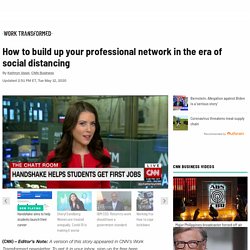
Love it or hate it, networking is instrumental to your career growth and job hunt. Well, different. But also the same. Current relationships. Keep checking in with people you know like friends, colleagues and acquaintances. Dormant relationships. Why many employees are hoping to work from home even after the pandemic is over. Like millions of Americans, Laura Hamill, chief people officer and chief science officer at software company Limeade, has been forced to work from home since early March in an effort to stop the spread of COVID-19.

Though today’s forced remote culture has been an adjustment for many, the mom of two teenagers says she looks forward to the possibility of working from home more often even after the pandemic subsides. “To me it sort of takes the edge off of the second shift,” she tells CNBC Make It. Twitter Will Allow Employees To Work At Home Forever. BuzzFeed News has reporters across five continents bringing you trustworthy stories about the impact of the coronavirus.
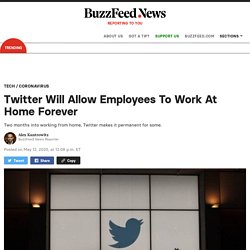
To help keep this news free, become a member and sign up for our newsletter, Outbreak Today. Some Twitter employees will never return to their office. Twitter CEO Jack Dorsey emailed employees on Tuesday telling them that they’d be allowed to work from home permanently, even after the coronavirus pandemic lockdown passes. Some jobs that require physical presence, such as maintaining servers, will still require employees to come in. Twitter Will Allow Employees To Work At Home Forever. Remote work worsens inequality by mostly helping high-income earners. The importance of remote work, also known as telecommuting, is evident during the current COVID-19 crisis.
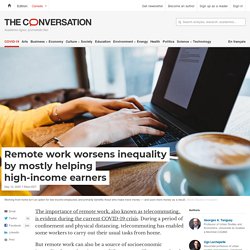
During a period of confinement and physical distancing, telecommuting has enabled some workers to carry out their usual tasks from home. But remote work can also be a source of socioeconomic inequality for workers in many different ways. These are related to the job sector and employers, as well as to the loss of the benefits associated with remote work. The Cubicle Is Back. Blame (or Thank) the Coronavirus.
Why many employees are hoping to work from home even after the pandemic is over. Is all-remote the future of work? Moreover, the survey’s Australian findings indicate that a remote work environment offers many compelling benefits for both employees and organisations and results in a more motivated and loyal workforce.

All-remote Improves Employee Retention All-remote is the purest form of remote work, and it is an approach that retains employees and attracts new talent. Fifty-two percent of the Australian survey respondents cited improved employee loyalty and retention as a top benefit to the employer by enabling a remote environment. Employees would also consider leaving their current co-located company for a remote role (58%). For millennials, employment is a public health challenge. Millennials now make up the largest share of the Canadian workforce and many are facing precarious working conditions.

As a society, we have previously assumed that if young Canadians invest in formal training and “pay their dues” in poor quality jobs early in their careers, they will work their way into better quality employment. A recent report from the Canadian Centre for Policy Alternatives (CCPA) suggests a different reality. The study, based on a national survey of 1,000 professionals, found that 22 per cent are working in precarious situations, characterized by contract work, part-time hours, unpredictable incomes and a lack of paid sick days. It reports that working in a professional job no longer provides Canadians with working conditions that are optimal for health, regardless of skills and training.
Zero-hour contracts take a huge mental and physical toll – poor eating habits, lack of sleep and relationship problems. The number of workers on zero-hours contracts continues to rise in the UK.
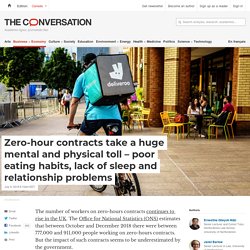
The Office for National Statistics (ONS) estimates that between October and December 2018 there were between 777,000 and 911,000 people working on zero-hours contracts. But the impact of such contracts seems to be underestimated by the government. An independent government review of modern working practices states that: “To ban zero-hours contracts in their totality would negatively impact many more people than it helped”. The gig economy is nothing new – it was standard practice in the 18th century. The Taylor Report, the UK government’s recent major review of modern work, paid particular attention to the “gig economy”.
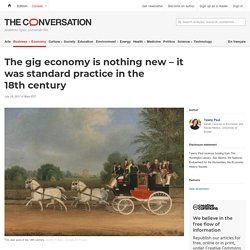
This is the idea that the traditional model of work – where people often have a clear career progression and a job for life – has been upended. It encompasses “self-employed” Uber drivers to the web developer freelancers and it allows workers more freedom – but also denies them benefits and protective regulation. While it might seem that long-established ways of working are being disrupted, history shows us that the one person, one career model is a relatively recent phenomenon. Prior to industrialisation in the 19th century, most people worked multiple jobs to piece together a living. Looking to the past uncovers some of the challenges, benefits and consequences of a gig economy. Ken Loach's new film on the gig economy tells exactly the same story as our research.
Ken Loach’s film, Sorry We Missed You, tells the harrowing tale of Ricky, Abby and their family’s attempts to get by in a precarious world of low paid jobs and the so-called “gig economy”.

But how realistic is it? Workers in the gig economy feel lonely and powerless. The gig economy is quickly becoming a central part of Canadian life.

The jobs aren’t just limited to Uber and Skip the Dishes. Grocery stores, laundries and more are banking on a new workforce that will accept jobs on a per-task basis. State of Remote Work 2019. The State of Remote Work is Buffer's annual report that showcases the world of remote workers and seeks to understand them. We asked nearly 2,500 remote workers to tell us about the benefits and struggles that come with remote work, what remote work looks like in their individual experience, and the structure of their companies that allowed for remote work in the first place.
We teamed up with other companies who are either fully remote or support remote work, to make this report possible. Thank you to our partners from Doist, Hubstaff, Remote-How, RemoteYear, Trello, Workfrom, and We Work Remotely who helped to make this report possible! How to Start Working Remotely One Day a Week. Ready for a life of flexibility and potential? Baby steps. Here are all the tips you need to work remotely one day a week.
Cold sweats. Biting your nails. Nervous jitters. Remote working – News, Research and Analysis – The Conversation – page 1. Andrew Glover Postdoctoral Research Fellow, RMIT University Stephanie Russell Principal Lecturer, Corporate Education, Faculty of Business and Law. Anglia Ruskin University. Human Resource Management, Anglia Ruskin University Ella Hafermalz Research assistant professor, Vrije Universiteit Amsterdam Tania Lewis Co-Director of the Digital Ethnography Research Centre and Professor of Media and Communication, RMIT University, RMIT University Martin Abel Assistant Professor of Economics, Middlebury Mohja Rhoads Research Consultant and Lecturer in Policy, Planning and Development, California State University, Dominguez Hills Fynnwin Prager Assistant Professor of Public Administration, California State University, Dominguez Hills.
How remote working can increase stress and reduce well-being. Remote working is becoming more popular than ever. A study released by the Swiss office provider IWG found that 70% of professionals work remotely at least one day a week, while 53% work remotely for at least half of the week. Some multinationals have their entire staff working remotely, with no fixed office presence at all, which can result in having employees situated all over the world. New technology makes all this possible. Top productivity killers in Canadian offices. Loud talkers and chatty colleagues (54%) Noisy recreation areas and ‘distracting’ open-concept workspaces (49%) Lack of a permanent desk/office (43%) Canadians (73%) believe they could save up to two hours of work each day if they were placed in an office designed to minimize distraction.
READ MORE: Are you crippled by the productivity paradox? “Imagine what your business could accomplish if you gave the one to two hours of daily lost productivity back to your team,” said Kane Willmott, iQ Offices CEO and co-founder. Co-working demystified: Behind the working world revolution. Co-working spaces have been growing in all the world’s major cities for 15 years.